DODGE TRUCK 1993 Service Repair Manual
Manufacturer: DODGE, Model Year: 1993, Model line: TRUCK, Model: DODGE TRUCK 1993Pages: 1502, PDF Size: 80.97 MB
Page 451 of 1502

8L
- 8
LAMPS
CONNECTOR
CUP
FRONT
LAMP
ASSEMBLY
LICENSE
PLATE
SCREW
LAMP
ASSEMBLY
LICENSE
PLATE
RR8LD24
Fig.
15
License
Plate
Lamps
-
Step
Bumper
TO
TAIL,
STOP,
TURN
SIG. AND
BACK
UP
LAMPS
LICENSE
PLATE
LICENSE
PLATE
LAMP
AND
LAMP
CONNECTOR
BRACKET
ASSEMBLY
J908L-74
Fig.
16
License
Plate
Lamp
Without Rear
Bumper
UNDERHOOD
LAMP
When equipped, the underhood lamp is installed on
the hood left, rear inner panel (Fig, 17). The lamp is
illuminated when the hood is opened (Fig. 18). UNDERHOOD LAMP BULB REPLACEMENT
REMOVAL
(1) Disconnect the wire connector from the under
hood lamp (Fig. 17).
(2) Rotate the bulb counter-clockwise. Remove it
from the lamp base socket (Fig. 18).
INSTALLATION
(1) Insert the replacement bulb in the lamp base
socket. Rotate it clockwise.
(2) Connect the wire connector to the lamp (Fig.
17).
UNDERHOOD LAMP REPLACEMENT
REMOVAL
(1) Disconnect the wire connector from the lamp
(Fig. 17). (2) Rotate the bulb counter-clockwise. Remove it
from the lamp base socket (Fig. 18). (3) Remove the screw that attaches the lamp re
flector and support bracket to the hood inner panel (Fig. 17).
(4) Remove the lamp from the hood inner panel.
INSTALLATION (1) Position the underhood lamp on the hood inner
panel. (2) Install the screw through the lamp and into the
hood panel (Fig. 17). Tighten the screw securely. (3) Insert a replacement bulb in the lamp base
socket (Fig. 18). Rotate it clockwise. (4) Connect the wire connector to the lamp (Fig.
17).
HOOD
J9223-446
Fig.
17
Underhood
Lamp
DAYTIME
RUNNING
LIGHT
MODULE
(CANADA
ONLY)
The headlamps on vehicles sold in Canada will il
luminate when the ignition is ON. The module also
receives a signal from the distance sensor. This pro-
SUPPORT
BRACKET RETAINER
LIQUID
TAB SWITCH
ENCLOSURE
WIRE
HARNESS
CONNECTOR
\
1
d1^—1—l
L/
CMD>
LAMP
REFLECTOR
BULB
(105)
BASE
J9281"1
Fig.
18
Underhood
Lamp
Components
Page 452 of 1502

LAMPS
8L - 9
vides a constant Lights On condition while the vehi
cle is rolling. The lamps illuminate at less than 50%
of normal intensity.
The Daytime Running Light Module is located on
the right inner fender (Fig. 19).
(1) Remove the bolt holding the module and
bracket to the vehicle. (2) Disconnect the electrical connector.
(3) To install the module, reverse the removal pro
cedures.
Fig.
19 Daytime Running Light Module
Page 453 of 1502
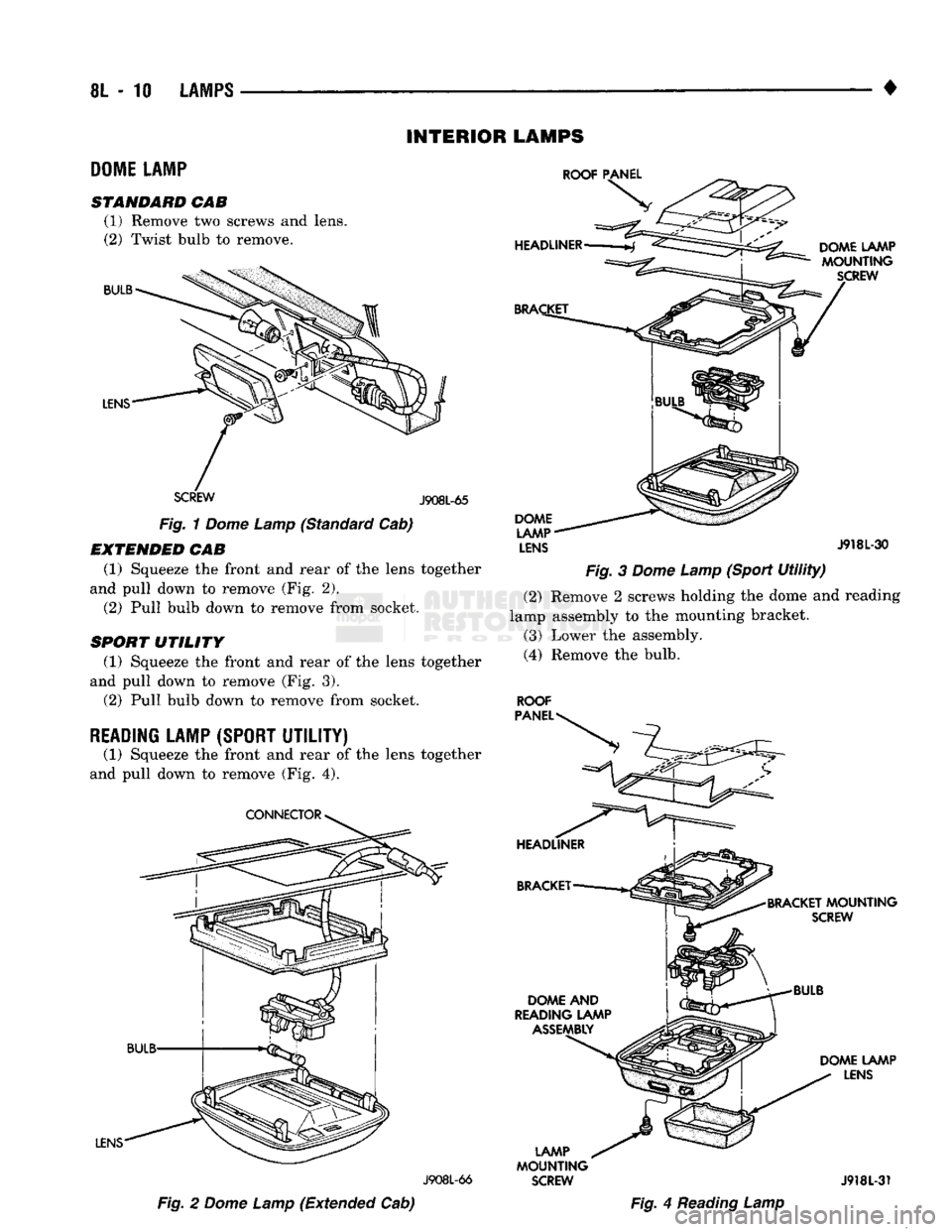
8L
- 10
LAMPS
•
INTERIOR
DOME LAMP
STANDARD
CAB (1) Remove two screws and lens.
(2) Twist bulb to remove.
LENS
SCREW
J908L-65
Fig.
1
Dome
Lamp
(Standard Cab)
EXTENDED
CAB (1) Squeeze the front and rear of the lens together
and pull down to remove (Fig. 2).
(2) Pull bulb down to remove from socket.
SPORT
UTILITY (1) Squeeze the front and rear of the lens together
and pull down to remove (Fig. 3). (2) Pull bulb down to remove from socket.
READING LAMP (SPORT
UTILITY)
(1) Squeeze the front and rear of the lens together
and pull down to remove (Fig. 4).
J908L-66
Fig.
2
Dome
Lamp
(Extended Cab)
LAMPS
LENS
J918L-30
Fig.
3
Dome
Lamp
(Sport
Utility)
(2) Remove 2 screws holding the dome and reading
lamp assembly to the mounting bracket.
(3) Lower the assembly.
(4) Remove the bulb.
ROOF
MOUNTING
SCREW
J918L-31
Fig.
4
Reading
Lamp
Page 454 of 1502

•
LAMPS
8L - 11
BULB
APPLICATION
GENERAL
INFORMATION
The following Bulb Application Table lists
the
lamp title
on the
left side
of the
column
and
part
number
on the
right.
CAUTION:
Do not use
bulbs
that
have
a
higher
can
dle power than
the
bulb
listed
in the
Bulb
Applica
tion Table.
Damage
to
lamp
can
result.
EXTERIOR LAMPS
Auxiliary Turn Signal (Snow Plow) 2057
Auxiliary Headlamps (Snow Plow) .6054
Back-up....................... .......1156 Cargo Lamp..
922
Clearance Lamps
194
Front Side Marker
168
Headlamp/Sealed Beam .6052
License Plate
168
Park/Turn Signal 2057
TaiyStop/Turn Signal ...2057
INTERIOR LAMPS
DIMMER CONTROLLED LAMPS Service procedures
for
most
of the
lamps
in the in
strument panel
are
located
in
Group
8E,
Instrument
Panel
and
Gauges. Some components have lamps
that
can
only
be
serviced
by an
Authorized Service Center (ASC). These components must
be
removed
from
the
vehicle
for
service. Contact local dealer
for
location
of
nearest
ASC.
A/C Heater Control
158
Ash Receiver
..158
Gear Shift Selector...........................................PC194
Heater Control
158
Instrument Cluster.. PC 194
Radio
ASC
Snow Plow Control
.158
INDICATOR LAMPS Service procedures
for
most
of the
lamps
in the in
strument panel,
and
switches
are
located
in
Group
8E,
Instrument Panel
and
Gauges. Anti-lock Brake PC194
Brake Warning PC194 Check Engine PC194
Engine
Oil
Pressure
158
Fasten Seat Belts.. PC 194 Four Wheel Drive ....158
Hazard Flasher
194
High Beam PC194
Low Fuel....... JPC194
Maintenance Required PC 194
Transmission Temperature ..PC 194 Turn Signal PC194
NON-DIMMING LAMPS Service procedures
for
most
of the
lamps
in the
fol
lowing list
can be
found
in
Group
23,
Body.
Dome
1004
Engine Compartment ...105 Glove Compartment....
1891
Ignition Lock
ASC
Reading Lamp
912
Page 455 of 1502

Page 456 of 1502
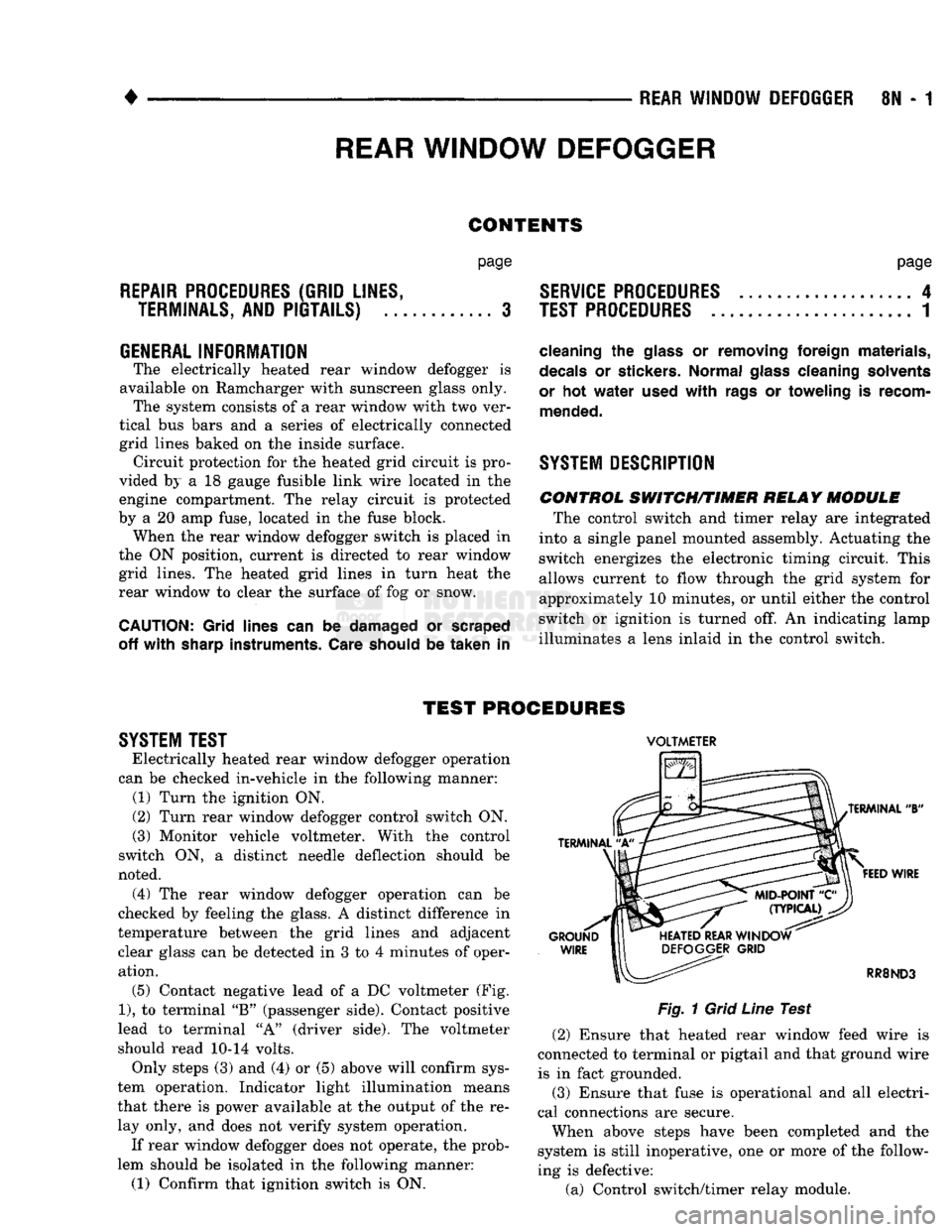
•
REAR
WINDOW DEFOGGER
8N - 1
REAR
WINDOW
DEFOGGER
CONTENTS
page
REPAIR
PROCEDURES (GRID LINES,
TERMINALS,
AND
PIGTAILS)
3
GENERAL
INFORMATION
The electrically heated rear window defogger
is
available
on
Ramcharger with sunscreen glass only. The system consists
of a
rear window with
two
ver
tical
bus
bars
and a
series
of
electrically connected
grid lines baked
on the
inside surface. Circuit protection
for the
heated grid circuit
is
pro
vided
by a 18
gauge fusible link wire located
in the
engine compartment.
The
relay circuit
is
protected
by
a 20 amp
fuse, located
in the
fuse block. When
the
rear window defogger switch
is
placed
in
the
ON
position, current
is
directed
to
rear window
grid lines.
The
heated grid lines
in
turn heat
the
rear window
to
clear
the
surface
of fog or
snow.
CAUTION;
Grid lines
can be
damaged
or
scraped
off
with
sharp instruments. Care should
be
taken
in
page
SERVICE
PROCEDURES
4
TEST
PROCEDURES
1
cleaning
the
glass
or
removing foreign materials,
decals
or
stickers. Normal
glass
cleaning solvents
or
hot
water
used
with
rags
or
toweling
is
recom mended.
SYSTEM
DESCRIPTION CONTROL
SWITCH/TIMER
RELAY MODULE
The control switch
and
timer relay
are
integrated
into
a
single panel mounted assembly. Actuating
the
switch energizes
the
electronic timing circuit. This
allows current
to
flow through
the
grid system
for
approximately
10
minutes,
or
until either
the
control
switch
or
ignition
is
turned
off. An
indicating lamp
illuminates
a
lens inlaid
in the
control switch.
TEST PROCEDURES
SYSTEM
TEST
Electrically heated rear window defogger operation
can
be
checked in-vehicle
in the
following manner: (1) Turn
the
ignition
ON.
(2) Turn rear window defogger control switch
ON.
(3) Monitor vehicle voltmeter. With
the
control
switch
ON, a
distinct needle deflection should
be
noted. (4)
The
rear window defogger operation
can be
checked
by
feeling
the
glass.
A
distinct difference
in
temperature between
the
grid lines
and
adjacent clear glass
can be
detected
in 3 to 4
minutes
of
operation. (5) Contact negative lead
of a DC
voltmeter
(Fig.
1),
to
terminal
"B"
(passenger side). Contact positive
lead
to
terminal
"A"
(driver side).
The
voltmeter
should read
10-14
volts. Only steps
(3) and (4) or (5)
above will confirm sys
tem operation. Indicator light illumination means
that there
is
power available
at the
output
of the re
lay only,
and
does
not
verify system operation.
If rear window defogger does
not
operate,
the
prob
lem should
be
isolated
in the
following manner:
(1) Confirm that ignition switch
is ON.
VOLTMETER
Fig.
1
Grid
Line
Test (2) Ensure that heated rear window feed wire
is
connected
to
terminal
or
pigtail
and
that ground wire
is
in
fact grounded.
(3) Ensure that fuse
is
operational
and all
electri
cal connections
are
secure.
When above steps have been completed
and the
system
is
still inoperative,
one or
more
of the
follow
ing
is
defective:
(a) Control switch/timer relay module.
Page 457 of 1502
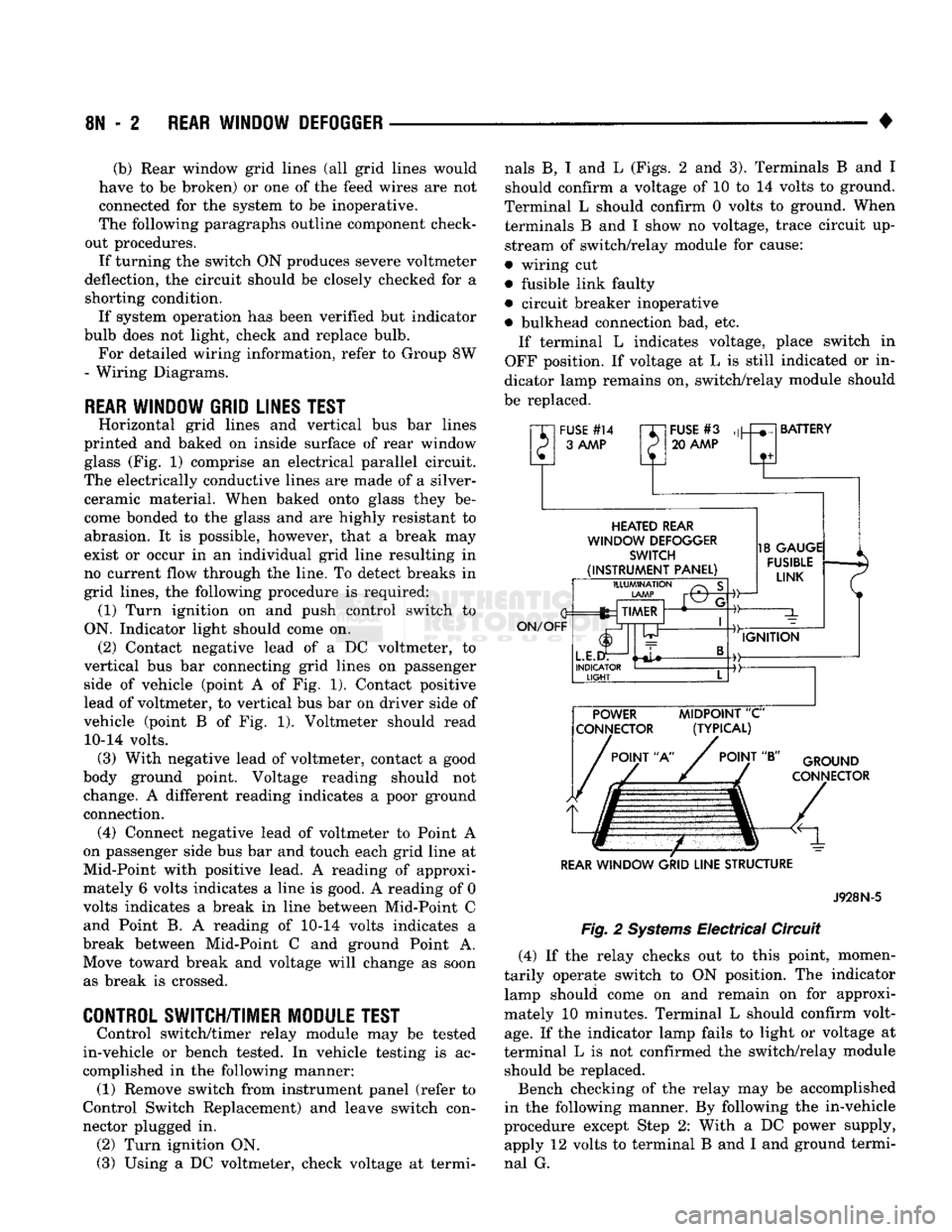
8N
- 2
REAR WINDOW DEFOGGER
• (b) Rear window grid lines (all grid lines would
have to be broken) or one of the feed wires are not
connected for the system to be inoperative.
The following paragraphs outline component check
out procedures.
If turning the switch ON produces severe voltmeter
deflection, the circuit should be closely checked for a shorting condition. If system operation has been verified but indicator
bulb does not light, check and replace bulb.
For detailed wiring information, refer to Group 8W
- Wiring Diagrams.
REAR
WINDOW GRID LINES TEST
Horizontal grid lines and vertical bus bar lines
printed and baked on inside surface of rear window glass (Fig. 1) comprise an electrical parallel circuit.
The electrically conductive lines are made of a silver- ceramic material. When baked onto glass they be
come bonded to the glass and are highly resistant to abrasion. It is possible, however, that a break may
exist or occur in an individual grid line resulting in
no current flow through the line. To detect breaks in
grid lines, the following procedure is required: (1) Turn ignition on and push control switch to
ON. Indicator light should come on. (2) Contact negative lead of a DC voltmeter, to
vertical bus bar connecting grid lines on passenger side of vehicle (point A of Fig. 1). Contact positive
lead of voltmeter, to vertical bus bar on driver side of
vehicle (point B of Fig. 1). Voltmeter should read 10-14 volts. (3) With negative lead of voltmeter, contact a good
body ground point. Voltage reading should not change. A different reading indicates a poor ground connection. (4) Connect negative lead of voltmeter to Point A
on passenger side bus bar and touch each grid line at
Mid-Point with positive lead. A reading of approxi mately 6 volts indicates a line is good. A reading of 0
volts indicates a break in line between Mid-Point C and Point B. A reading of 10-14 volts indicates a
break between Mid-Point C and ground Point A. Move toward break and voltage will change as soon as break is crossed.
CONTROL SWITCH/TIMER MODULE TEST
Control switch/timer relay module may be tested
in-vehicle or bench tested. In vehicle testing is ac
complished in the following manner: (1) Remove switch from instrument panel (refer to
Control Switch Replacement) and leave switch con
nector plugged in. (2) Turn ignition ON.
(3) Using a DC voltmeter, check voltage at termi nals B, I and L (Figs. 2 and 3). Terminals B and I
should confirm a voltage of 10 to 14 volts to ground.
Terminal L should confirm 0 volts to ground. When terminals B and I show no voltage, trace circuit up
stream of switch/relay module for cause:
• wiring cut
• fusible link faulty
• circuit breaker inoperative
• bulkhead connection bad, etc. If terminal L indicates voltage, place switch in
OFF position. If voltage at L is still indicated or in
dicator lamp remains on, switch/relay module should
be replaced.
"XI
FUSE
#14
rr~
P 3
AAAP
P
FUSE
#3
20
AAAP
BATTERY
HEATED
REAR
WINDOW
DEFOGGER
SWITCH
(INSTRUMENT
PANEL)
ON/OFF
ILLUMINATION
LAMP
fez TIMER
L.E.I
INDICATOR
LIGHT
-©-
18
GAUGE
FUSIBLE
LINK
IGNITION POWER
MIDPOINT
"C"
CONNECTOR (TYPICAL)
POINT
"A"
POINT
"B"
GROUND
CONNECTOR
REAR
WINDOW
GRID
LINE
STRUCTURE
Fig.
2
Systems
Electrical Circuit
J928N-5
(4) If the relay checks out to this point, momen
tarily operate switch to ON position. The indicator lamp should come on and remain on for approxi
mately 10 minutes. Terminal L should confirm volt
age.
If the indicator lamp fails to light or voltage at
terminal L is not confirmed the switch/relay module should be replaced.
Bench checking of the relay may be accomplished
in the following manner. By following the in-vehicle
procedure except Step 2: With a DC power supply, apply 12 volts to terminal B and I and ground termi
nal G.
Page 458 of 1502
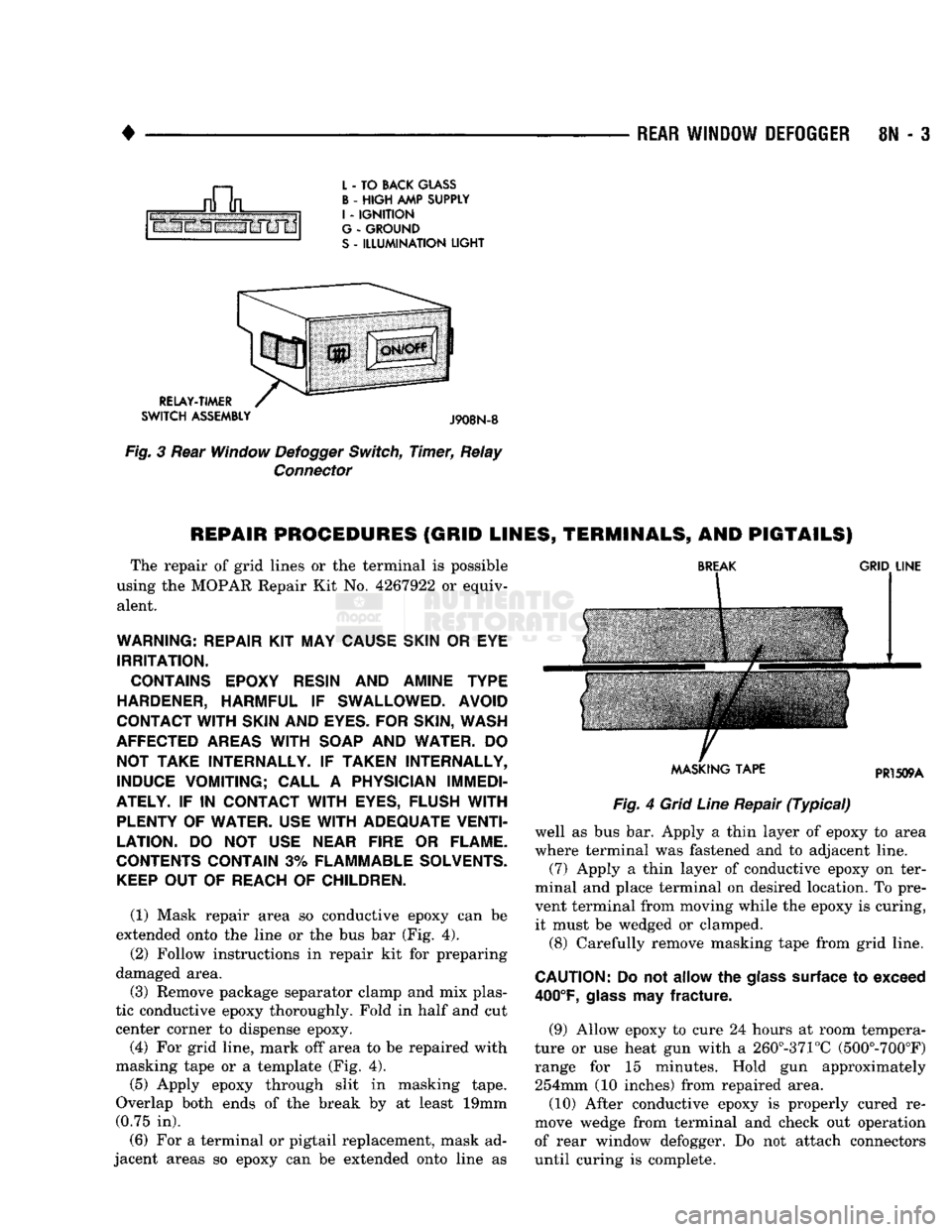
e
,
REAR
WINDOW
DEFOGGER
8N
- 3
L
-
TO
BACK GLASS
B
-
HIGH
AMP
SUPPLY
I
-
IGNITION
G
-
GROUND
S
-
ILLUMINATION
LIGHT
RELAY-TIMER
SWITCH
ASSEMBLY
J908N-8
Fig.
3
Rear Window Defogger
Switch,
Timer,
Relay
Connector
REPAIR
PROCEDURES
(GRID LINES, TERMINALS* AND PIGTAILS)
The
repair
of
grid lines
or the
terminal
is
possible
using
the
MOPAR Repair
Kit
No. 4267922
or
equiv alent.
WARNING: REPAIR
KIT
MAY
CAUSE SKIN
OR
EYE
IRRITATION.
CONTAINS EPOXY RESIN
AND
AMINE TYPE
HARDENER,
HARMFUL
IF
SWALLOWED. AVOID
CONTACT
WITH
SKIN
AND
EYES.
FOR
SKIN,
WASH
AFFECTED AREAS
WITH
SOAP
AND
WATER.
DO
NOT TAKE INTERNALLY.
IF
TAKEN INTERNALLY,
INDUCE VOMITING; CALL
A
PHYSICIAN IMMEDI
ATELY.
IF IN
CONTACT
WITH
EYES,
FLUSH
WITH
PLENTY
OF
WATER.
USE WITH
ADEQUATE VENTI
LATION.
DO
NOT USE
NEAR FIRE
OR
FLAME.
CONTENTS CONTAIN
3%
FLAMMABLE SOLVENTS.
KEEP
OUT
OF
REACH
OF
CHILDREN.
(1) Mask repair area
so
conductive epoxy
can be
extended onto
the
line
or the bus bar
(Fig.
4).
(2) Follow instructions
in
repair
kit for
preparing
damaged area.
(3) Remove package separator clamp
and mix
plas
tic conductive epoxy thoroughly. Fold
in
half and
cut
center corner
to
dispense epoxy.
(4)
For
grid line, mark
off
area
to be
repaired with
masking tape
or a
template (Fig.
4).
(5) Apply epoxy through slit
in
masking tape.
Overlap both ends
of the
break
by at
least
19mm
(0.75
in).
(6)
For a
terminal
or
pigtail replacement, mask
ad
jacent areas
so
epoxy
can be
extended onto line
as
BREAK
GRID
LINE
MASKING TAPE PR1509A
Fig.
4
Grid
Line
Repair
(Typical)
well
as bus bar.
Apply
a
thin layer
of
epoxy
to
area
where terminal
was
fastened
and to
adjacent line.
(7) Apply
a
thin layer
of
conductive epoxy
on
ter
minal
and
place terminal
on
desired location.
To
pre
vent terminal from moving while
the
epoxy
is
curing, it must
be
wedged
or
clamped.
(8) Carefully remove masking tape from grid line.
CAUTION:
Do not
allow
the
glass
surface
to
exceed
400°F,
glass
may
fracture.
(9) Allow epoxy
to
cure
24
hours
at
room tempera
ture
or use
heat
gun
with
a
260°-371°C (500°-700°F) range
for 15
minutes. Hold
gun
approximately 254mm
(10
inches) from repaired area.
(10) After conductive epoxy
is
properly cured
re
move wedge from terminal
and
check
out
operation
of rear window defogger.
Do not
attach connectors
until curing
is
complete.
Page 459 of 1502
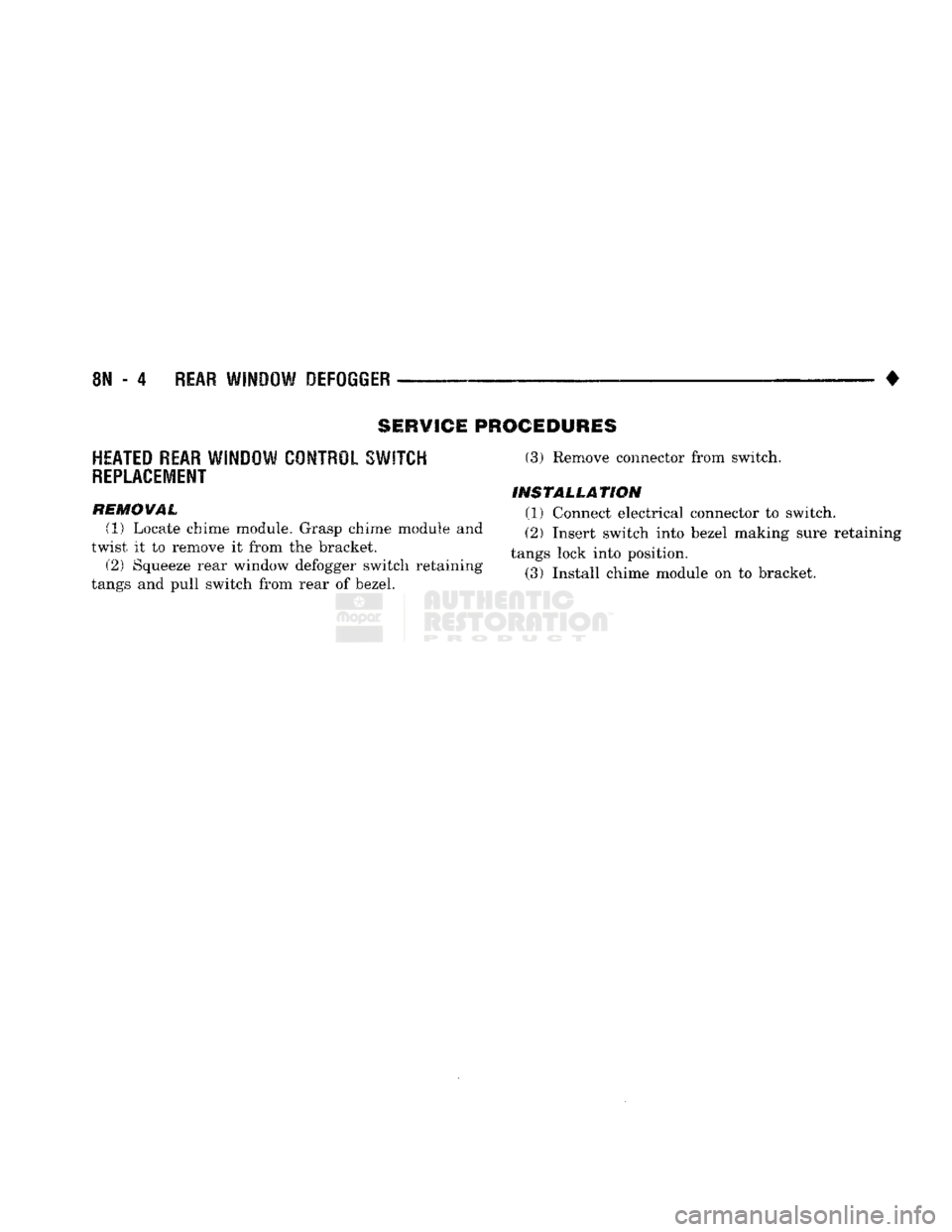
81 - 4
REAR
WINDOW
DEFOGGER
•
SERVICE
PROCEDURES
HEATED
REAR
WINDOW
CONTROL
SWITCH
REPLACEMENT
REMOVAL (1) Locate chime module. Grasp chime module and
twist it to remove it from the bracket. (2) Squeeze rear window defogger switch retaining
tangs and pull switch from rear of bezel. (3) Remove connector from switch.
INSTALLATION (1) Connect electrical connector to switch.
(2) Insert switch into bezel making sure retaining
tangs lock into position.
(3) Install chime module on to bracket.
Page 460 of 1502

•
POWER DOOR LOCKS
8P - 1
POWER DOOR LOCKS
CONTENTS
SERVICE
PROCEDURES
page
..
2
TEST PROCEDURES
page
..
1
equipped,
can be
by operating
the
GENERAL
INFORMATION
Both doors, when electrically
locked
or
unlocked electrically switch
on a
door panel. Both doors
can be
locked
or
unlocked mechanically
with
the
locking knob regardless
of
electrical locking and unlocking actuation.
TEST
PROCEDURES
The right
and
left front door
on all
vehicles
can be
locked
or
unlocked mechanically from
the
outside
with
the key or
electrically
as
described above.
The
left door
can
also
be
unlocked
by
actuation
of
the
in
side remote door handle.
FUSE
TEST
Locate
the
fuse
in
fuse cavity number
6 on the
fuse
block.
If
fuse
is
blown, replace
it. If
fuse blows again refer
to
Switch Test
and
Voltage Test procedures
to
find
the
short circuit.
SWITCH TEST
For switch testing, remove
the
switch from
its
mounting location. Using
an
ohmmeter, refer
to
(Fig. 1)
to
determine
if
continuity
is
correct
in the
Lock
and Unlock switch positions.
If
these results
are not
obtained, replace
the
switch. ®
3 SWITCH
POSITION
CONTINUITY
BOWEIN
OFF PINS
1 & 4
PINS
2 & 5
LOCK PINS
2 & 3
PINS
1 & 4
UNLOCK
PINS
3 &4
PINS
2 &5
PIN IDENTIFICATION
PIN SIDE
OF
SWITCH
Fig.
1
Door Lock
Switch
Continuity
VOLTAGE TEST
The following wiring test sequence determines
whether
or not
voltage
is
continuous through
the
body harness
to
switch. After removing switch from trim panel
for
testing
purposes, carefully separate multiple terminal block
on wiring harness from switch body. Connect
one
lead
of
test light
to
black wire terminal
and
touch other test light lead
to red
wire terminal.
If
the test
light comes
on, the
wiring circuit between
the
bat
tery
and
switch
is
functional.
If
light does
not
come
on, check
20 amp
fuse
or for a
broken wire.
ELECTRIC MOTOR TEST
Make certain battery
is in
normal condition before
circuits
are
tested. To determine which motor
is
defective, check each
individual door switch
for
lock
and
unlock
or
discon
nect
the
motors,
one at a
time, then operate
the
door lock switch.
In the
event that none
of the
motors
work,
the
problem may
be
caused
by a
shorted motor. Disconnecting
the
defective motor will allow
the
other
to
work. To test
an
individual door lock motor, disconnect
the wire connector
at the
motor. Apply
12
volts across
the
motor terminals
to
check
its
operation
in
one direction. Reverse
the
polarity
to
check
the
oper ation
in the
other direction.
If the
motor works,
check
the
wire harness
for
broken wires
or bad
con
nections.
If
the motor does
not
work, replace
it.
Should
the
motor malfunction
be the
result
of
bro
ken wiring
or an
internal open circuit,
it
should have no effect
on the
operation
of
the other motor.